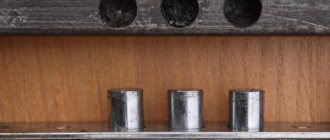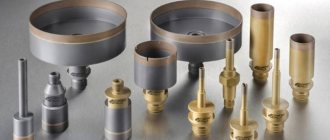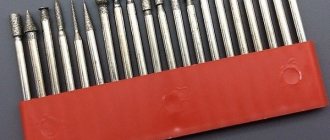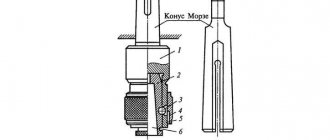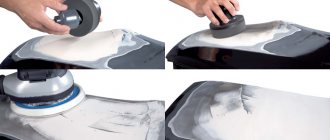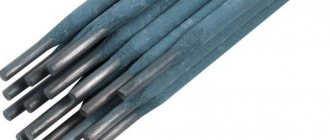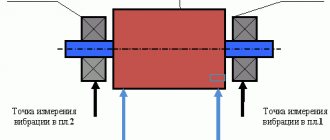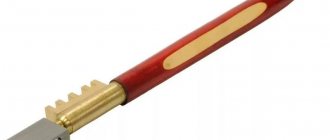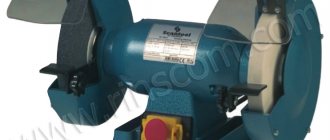A diamond needle file is an essential tool for any craftsman. You can even do jewelry work with it. A huge selection of different shapes and sizes makes it possible to reach the most difficult areas of an object and give corners and surfaces the proper look. But even such a simple tool has its own characteristics. We will talk about them in this article.
Is this a file?
A diamond file is a small file. The working surface of the device is coated with diamond coating. This ensures not just cutting the material during operation, but also scraping its surface, removing the thin layer located at the top. An ordinary nail file is also a type of needle file.
Diamond is one of the most expensive natural materials. But for what purpose is it used in the instrument? In reality, a stone of artificial origin is taken to create the device. Due to its high strength, diamond-coated needle files can work with glass, ceramics, durable steel and alloys.
A set of diamond tools allows a toolmaker to process the surface of a profile with a complex structure. Essentially, the devices perform the same functions as their steel counterparts, but cope with materials with a harder texture.
How to use a needle file?
The rules for using tools must be followed to increase their service life. Knowing how to use a needle file correctly, you can be sure that it will last for a long time.
- When grinding surfaces, files should be selected according to the hardness of the material.
- To prevent the needle file from clogging when working with soft alloys, it is recommended to treat its surface with chalk.
- It is not recommended to use a newly purchased file for hard surfaces; it must first “break in.”
- Rusty and contaminated materials should be cleaned before filing.
- Before working with a needle file, you must wear special clothing and glasses.
Size, grain size, product marking
The name of diamond needle files, as well as their shape and dimensions are regulated by GOST 151Z-67.
The length of the devices varies and ranges from 100 to 200 mm. As a rule, the most common models in stores are the lengths of 80, 120 and 160 mm. Moreover, the length of their working surface is 50, 60 and 80 mm, respectively.
The material from which the files are made must be harder than steel. When manufacturing a tool such as a diamond needle file, GOST 1435 and 5950 require the inclusion of carbon steel of the following categories: U12, U12 A, U 13, U 13 A, 13X. Hardness must be at least 55-58 units on the HRC scale.
Another important indicator is grain size. It lies in the size of diamond grains. The grain size is indicated by colored stripes or small marks. Such symbols can be seen on the handle of the device. They don't wash off.
It is easy to decipher the grain size:
- One red stripe or two small risks indicate that the indicator is 160/125-100/80.
- The presence of one blue stripe or one risk occurs at an indicator of 80/63-63/55.
- Models with the smallest grain size do not have any distinctive marks. This category includes devices with an indicator of 50/40-40/28.
How to clean a needle file?
Over time, the cut of any files can become clogged with waste metal residues and other small particles. The easiest way is to throw away the old tool and buy a new one, but it can be cleaned. A simple technology will help in cleaning wood and metal files. A dirty file must be cleaned of dirt using soapy liquid or dishwashing detergent, and the tool must be rinsed under running water. After this, you can restore the surface using one of the following methods:
- Place the file in acetone so that the liquid completely covers the tool.
- Boil in a solution with soda for 15-20 minutes, then cool and rinse.
- Prepare a 20% solution of sulfuric acid and immerse the file in it until it is restored, act very carefully, because the acid is dangerous.
- After restoration, the tool must be kept in machine oil heated to 100°C for 20-30 minutes, cooled and wiped dry with a soft cloth.
What shapes do needle files have?
Diamond needle files are available in 12 types.
- Tools with three edges. They have a sharp or blunt end. This indicator determines the area of use of the device.
- Devices made in the shape of a rhombus. They make it possible to play with notches at a certain angle.
- Wedge-shaped devices are used when working with castes and valves (jewelry elements), as well as with angles with small values. Wedge-shaped devices have both a sharp and a rounded edge, but the nose of the device is sharp.
- The flat diamond needle file has versatility of use. The area of use depends on the size of the device.
- Grooved devices are similar to flat ones, but the edges on the sides are rounded. This makes it possible to treat hard-to-reach areas.
- Square devices are designed to work with grooves of a similar shape.
- With a semicircular shape. With their help it is possible to work with reliefs.
- Needle files with different convexities process the inner part of the ring.
- Oval fixtures are designed for holes.
- The round diamond needle file is able to work with rounded products. In addition, with their help, the required relief is created.
- The needle shape is fundamentally different from all other types. Firstly, it should be noted that these devices are miniature. The length of the working surface is 35-55 mm. Secondly, their tail is square.
- Another special type is the needle file. It should be discussed separately.
Devices with a blunt nose have the same cross-sectional size along their entire length. In pointed models, the cross-section of the rod decreases towards the edge of the device.
The notching itself is also performed in accordance with the standards. The main working parts of the tool have a double notch: main and auxiliary. Tools with a round or oval shape can have a single or spiral single cut.
What types of pens are there?
The file handle greatly simplifies the work process. Without this device, the master will easily rub the skin of his hands, lose precision of movement, and drop the slippery metal.
The comfortable handle has no nicks or burrs, it is smooth and easily fits into the curve of the palm. Markings are visible on the surface. The most convenient proportions are equal to the length of the file and the holder.
Some mini files already come with handles made of plastic, wood or rubber. But there are single copies and sets without this. Manufacturers offer to purchase amenities separately
In such cases, it is recommended to pay attention to the quick-release handle for the file. The most common option is a wooden block with a hole for the tool.
A special bushing protects the device from splitting and increases service life. You can put the handle on by lightly hitting the workbench or gently tapping it with a hammer.
A more modern and optimal option for a removable holder is a handle with a collet clamp. The spring eliminates the need for shock when putting on and taking off. The movable sleeve securely fixes the file with one turn, then releases it in the reverse order. These handles are made from stainless steel or durable wood. The case often has a cavity for storing the files themselves.
Removable handles with collets fit different shank diameters. This is especially convenient for craftsmen with a large collection of needle files.
Pneumatic needle files have special holders. They often have a complex design that can be transformed into a file model.
How to make a pen yourself
Each file can be equipped with a handle without going to the store. Craftsmen have come up with a lot of ways to avoid unnecessary expenses. With the use of improvised means, no less functional handles are obtained. Most don't take more than half an hour to make. Examples include the following options:
- empty gas cans. These are used in pneumatic weapons and siphons. Using a thin round file, carefully bore the hole on top of the cylinder to the diameter of the shank. There is no reserve left, the size is taken end to end. Several handles can be made for different diameters;
- wooden block. It is necessary to sand the surface, drill a hole of the required size, and coat it with varnish for wear resistance;
- epoxy resin. A bar or handle of a different shape is cast from the composition. Insert the file and wait until it hardens completely. As a form, you can use, for example, a narrow tall glass, a box or a test tube. Resin is also used to strengthen wooden handles and reduce unfortunate large holes in workpieces;
- handles from old knives and screwdrivers. Remove the metal element. Adjust the hole using a drill. Heat the shank of the file, insert it into the workpiece and fix it until it hardens;
- rubber. In a piece of rubber of the desired shape, make a hole slightly smaller than the diameter of the needle file. Insert file;
- Toothbrush. Cut off the top part with the bristles. Drill a hole, heat the file, insert and secure in the same way as with handles for knives/screwdrivers;
- mounting anchor. If you have certain skills, you can make a clamping handle from a regular anchor. A rubber heat-shrink tube is placed on top for an anti-slip effect.
The above are just some folk inventions. Human imagination is limitless and allows you to come up with many more options.
What determines the tool number?
The number of notches per 10 mm of product length determines its number. Manufacturers always indicate the tool number from 0 to 8. It is important to know: the higher the number, the more notches the tool has, which means that the teeth themselves are small, and the surface during processing will be smoother.
The length of the working surface of the file is always half as long as its total length. As already mentioned, it comes in three sizes: 50, 60 and 80 mm. A very important point should be noted here - the number of the notch depends on the type of size:
- devices with a working part length of 50 mm can have notches from 1 to 8;
- tools with an indicator of 60 mm can have notches from 1 to 7;
- instruments with a length of 80 mm are equipped with notches from 0 to 6.
It is difficult to say why this rule was chosen. Diamond needle files are produced according to a specific GOST, and you just need to figure out what set of devices exists in size.
What parameters should you pay attention to when choosing a tool?
If you decide to buy a diamond needle file, carefully examine the cut on the tool. There should be no defects, chips or cracks on it. The color of the canvas is uniform, without traces of rust. Also check to see if the diamond powder is peeling off from the base. Let us list a few more criteria for choosing a tool.
File handle
Files are produced with wooden, plastic and rubber handles. All types are convenient to use, so this parameter is not particularly important. There are also tool sets without handles. In this case, you can modify the file yourself by turning a handle from wood or using a plastic blank (for example, an old toothbrush).
Photo #3: Set of needle files with removable plastic handle
Set contents
If you buy needle files in sets, sets of 6–10 products of the most common shapes are suitable for household use. The lengths and number of notches on the tool are indicated on the box.
Photo #4: Set of 11 tools
Tool quality assessment
Checking the quality of a tool is quite simple. To do this, take two files and run the work blades over each other. A high-quality notch will not be damaged or erased. The color of the canvas and its texture will remain the same.
What kind of work are tools used for depending on the size of the teeth?
Tools with large teeth are needed for working with large surfaces or where large layers of metal must be removed. For example, such work can be done with a file with three edges and a large notch.
A medium-sized notch is more suitable for working with soft metals: brass, aluminum, bronze. Such needle files do an excellent job of polishing water pipe couplings for their optimal joining or removing nicks without “licking” the product.
The smallest teeth are designed for filigree work. The tools are able to enlarge the wedge groove on the electric motor shaft. They can clean burnt contacts of current collectors used in everyday life (sockets, circuit breakers, etc.).
There is a special notch that is located along the body of the device, and not transversely, as is customary. In this case, the cross-section of the canvas has a round shape. This diamond needle file is used for sharpening knives at home. It has its own name - musat. Sharpening proceeds more accurately and also much faster than with sandpaper.
On the market you can also see needle files of unusual shapes, which are extremely rare. They have a curved shape. Tools are used for processing internal curved grooves. As a rule, such devices have a notch on both ends of the instrument, and the handle is located in the middle.
The difference between a file and a rasp and a needle file
Among the many options, there are two distinctive types. Externally, they repeat the nomenclature of files. But there are also fundamental differences.
Rasp
It has a long length and a large dot notch. They are mainly used to process large products made of wood, plastic and hard rubber. There are general purpose and specialized ones - for shoemakers and for stripping horses’ hooves before shoeing them. The scope of application is determined by the geometric shapes. Their production does not require expensive grades of steel.
Needle file
This tool is small in size, working length 80, 120, 160 mm. Its characteristics are specified in GOST 1513-77. It is used for engraving and jewelry making. The tool is convenient in places where access is difficult.
GOST 1513-77 Needle files. Specifications
1 file 275.88 KB In total, 11 subgroups are distinguished based on appearance. Needle files are made from various grades of carbon steel, including those with a working part coated with diamond chips.
There is a variety called "rifel". This tool has a curved working part. It is made from magnetic alloys. Due to this property, when filing jewelry, iron filings are magnetized to the steel and separated from the precious metals.
The file is one of the oldest human working tools. Its versatility in skillful hands allows the master to perform almost any job. Both in the home workshop and in production, it is necessary to have a set of as many different standard sizes as possible.
Tool Manufacturers Review
There are many companies on the market that manufacture this device. It should be noted such domestic ones, “Bison”. Products from Russian companies have gained wide popularity due to their reasonable cost and high level of functionality. They are in great demand.
Foreign models are also presented: Vallorbe, Bahco, Jonnesway, Matrix, Stanley, Stayer, Sturm. Foreign analogues are comparatively more expensive. Craftsmen note that the set of diamond needle files Matrix, Stayer, Sturm has a minus. The tools of these brands are not durable.
ACCEPTANCE
4.1. Acceptance rules - according to GOST 23726.
(Changed edition, Amendment No. 3).
4.2. (Deleted, Amendment No. 3).
4.3. Periodic tests, including tests for average life, should be carried out once every 3 years, on at least 5 needle files, for a specified life - once a year, at least on 5 files.
5 pieces are tested. flat, blunt-nosed files on two wide sides, made by cutting and notching.
(Changed edition, Amendment No. 3).
Needle file handle ensures comfortable operation
The handle can be made of wood, plastic or rubber-coated plastic. If it is not there, then you should make the part yourself.
The best option would be to turn and polish a wooden handle. A toothbrush base with a hole drilled and centered from the inside can replace a plastic handle.
The main criteria for the tool should be cost-effectiveness and convenience. This is when you will be able to work with it for a long time.
Numbering of notches and types of work
Based on the size of the teeth, the notches are divided into 5 classes:
| Class No. | Layer of material to be removed | Characteristic |
| 0-1 | 0.05 to 0.1 mm | The largest type of notches is inconvenient because when processing metal ones, errors of 0.1 to 0.2 mm are likely |
| 2-3 | 0.02 to 0.06 mm | The best option for removing a layer of metal, but protecting grooves and holes can be difficult |
| 4-5 | 0.01 to 0.03 mm | Notches with teeth N 4 and 5 are used for finishing parts and subordinating grooves and holes. Maximum error allowed during operation – 0.001 – 0.005 mm |
In addition to class, the geometry of the file teeth must comply with GOST 1465-80 clause 2.1, which requires that the notch be applied at an angle of 65 degrees relative to the steel beam. This paragraph also stipulates the features of the manufacturing technology of a particular type of file. Thus, round files must be produced by notching or threading, while other file shapes are produced by notching only.
